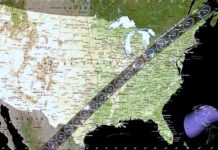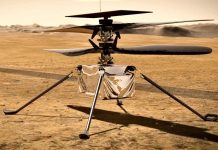
KENNEDY SPACE CENTER, Fla., May 4 (UPI) — The Dream Chaser spaceplane, a cargo spacecraft built and operated by Nevada-based Sierra Nevada Corp., is to begin launching and landing in Florida in 2022, NASA and the company announced Tuesday.
The uncrewed, robotic spaceplane will be launched aboard a United Launch Alliance rocket from Kennedy Space Center for flights to the International Space Station.
Once it docks and delivers cargo, Dream Chaser will return to the space center’s former space shuttle landing strip.
The first Dream Chaser is being prepared for delivery to the space center next spring, Janet Kavandi, a former astronaut and an executive vice president of Sierra Nevada, said during a press conference Tuesday on the landing strip.
“When we first launch next year, 2022, at the end of that mission, we plan to come back and land here at this very runway,” Kavandi said.
She was joined on the tarmac by Kennedy Space Center director Bob Cabana and Frank DiBello, executive director of Space Florida, the state’s development agency for space, which manages the landing facility.
Space Florida has signed a contract to allow use of the landing facility, and the Federal Aviation Administration has licensed the spaceplane for landings there, DiBello said.
Cabana said that Sierra Nevada’s plans for Kennedy are further evidence that the space center is truly a multi-user, commercial spaceport rather than just a NASA facility.
Sierra Nevada planned to tour the space center and adjacent Cape Canaveral Space Force Station on Tuesday and Wednesday to search for a suitable building to process Dream Chaser between launches, Kavandi said.
“We’ll look first at existing facilities on government property, but we may also consider building something ourselves if needed,” she said.
The company also plans to hire dozens of people in the region for processing and other possible engineering functions, she said.
Sierra Nevada is one of a growing number of commercial space companies vying for NASA business. The company lost a competition in 2014 to SpaceX and Boeing to deliver astronauts to the space station using Dream Chaser.
SpaceX delivered on its astronaut contract in 2020 with the Crew Dragon capsule, while Boeing still plans a test flight of the Starliner capsule later this year.
But Sierra Nevada has won over $2 billion in NASA contracts to develop Dream Chaser as a reusable cargo vessel. The company plans at least seven cargo trips for NASA.
At just 30 feet long, the spacecraft is only one-quarter the size of the space shuttle.
The spaceplane’s ability to land at the space center — instead of splashing down at sea like SpaceX’s cargo capsule — would result in a faster return of science and materials from the space station, according to NASA and Sierra Nevada.
Dream Chaser would return to Earth under its own power. Since it doesn’t carry people, no test flights beyond short drops from aircraft completed in 2013 and 2017 are required.
The test flights were done with prototypes. The spacecraft has yet to launch as intended on a rocket sent into space. That rocket will be ULA’s new Vulcan Centaur, which is being developed.
Sierra Nevada executives have said they believe Dream Chaser can carry people someday, and that it would be more appealing to space tourists. That’s because it resembles a plane and doesn’t land with a jolt under parachutes like a space capsule.
Sierra Nevada plans to use the craft to launch and build its own orbiting habitat in space before NASA retires the space station around 2028.
The company’s orbiting space station has no name yet, but it would consist of inflatable sections connected by hardware, Kavandi said during a press conference in March.
“We plan to launch our vehicles to a platform with inflatable modules where both uncrewed and crewed vehicles take people and cargo … and then return safely to Earth,” Kavandi said.
Sierra Nevada has held numerous contracts for NASA and other space interests since it was founded in 1963.
The company has grown since Turkish American businesspeople, wife and husband Eren Ozmen and Fatih Ozmen, bought it in 1994. Eren Ozmen is chairwoman and president, while Fatih Ozmen is CEO.






